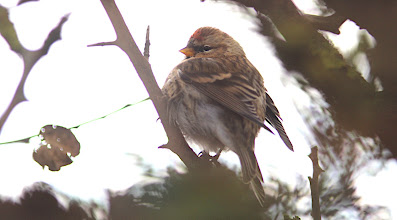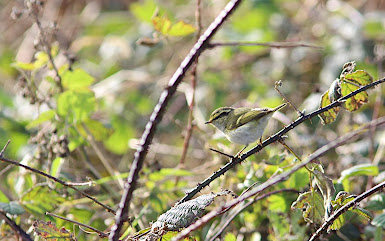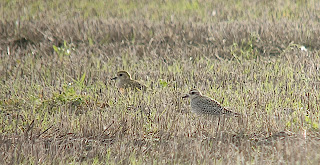Hit the Cape with old mate Dunc and our timing was spot-on. The day before, an arrival of rare birds had occurred at the Outer Head at Flamborough, in the Lighthouse Grasslands, including Flamborough's first Two-barred Warbler. We headed east early, hoping that some of these birds had stayed overnight. Emerging from the fog of the Yorkshire Wolds, sunny skies lit up the headland and I was slightly anxious that some of the migrants had moved on. To our delight, the main focus of our quest, Britain's eleventh Two-barred Warbler was apparently still bouncing around in the brambles.
We headed straight down there. Fieldfares chacked overhead, whilst Goldcrests crept through the tussocky grass. Arriving in the right spot, I could see about a dozen birders watching a bramble patch. I asked a nearby birder if the bird was here. He grabbed my shoulder and pointed about five metres away. There hopping about on the near edge of the patch, was the stripy sprite.
Flamborough's first Two-barred Warbler.Tiny, but chunkier than a Yellow-brow, the bird moved through the brambles and grass straight towards us, showing off its double-wingbars, orange lower mandible and importantly, plain olive-green tertials. The greater covert bar was white, long and broad and contrasted with a rather yellow supercilium which was long and flared behind the eye. The half dozen birders present remained silent and stock-still, and the bird came within about two metres, giving us sensational views. I couldn't believe it, and as it zipped off into another bramble patch, I looked round, to see Dunc and the others all beaming massive smiles! A cracking start to the day.
With so many birds around, we felt we'd head off round the Old Fall loop to see what we could find. Several Woodcocks exploded from their unseen hiding places, while a couple of showing off its double-wingbars, orange lower mandible to the beak and importantly, plain olive-green tertials Mealy Redpolls fed low down along the hedgeside. Blackbirds, Song Thrushes, Redwings and Fieldfares constantly dropped into the hedge, or scooted out as we approached, or evaded the attentions of three hunting Sparrowhawks.
Intriguingly, two Coal Tits flew out of the plantation and headed off high west across the fields; quite possibly continental immigrants, but with only flight views, I couldn't be sure. A few Siskins and Bramblings added to the scene, but we soon arrived back at the lighthouse, where news that a Pallas's Warbler, the most striped of sprites, had joined the Two-barred Warbler. Back to the lighthouse grassland we went. First, a Dusky Warbler showed briefly, but soon dived back into cover, true to their skulking form, Then, in a nearby bramble patch, the tiny sprite was located.
The Pallas's Warbler remained hidden in the depths of the tangle, but every now and again, appeared on top of a briar, giving stunning views. Pallas's Warblers are one of the classic east coast October sibes and it is always makes my autumn if I get to see one. This bird gave sublime views, occasionally shooting vertically to snap an insect, almost appearing hummingbird-like. The pale lemon rump flashed as it darted across the tops of the dark brambles.
Pallas's Warbler, Lighthouse GrasslandsWith three fantastic warblers seen, it was time for a celebratory coffee from the cafe and a brief pause to decide on plans. Dunc hadn't yet seen the Red-headed Bunting, so off we trudged along the clifftop. A tense fifteen minutes after arriving at North Marsh, a birder spotted the rather drab bird sitting in a bramble. It had been feeding in the stubble field and had hopped up for a rest. Fortunately, it remained in position for several minutes, so everybody present managed to get great views.
Red-headed Bunting at North Marsh.Time was getting on, and with birds still arriving from the sea, we decided on one last tramp round the Lighthouse Grasslands. A few Bramblings were fresh in on the Motorway Hedge, and the Fog Station compound held several Robins and a very dark Song Thrush. Redwings fed desperately on the clifftop path and yet more Fieldfares came in off.
Our day had rushed by in a flurry of exciting birds and hordes of common migrants. It had been fantastic and it was hard to drag ourselves away, yet Manchester was calling, where later we would finish the day watching two of our favourite bands.







































